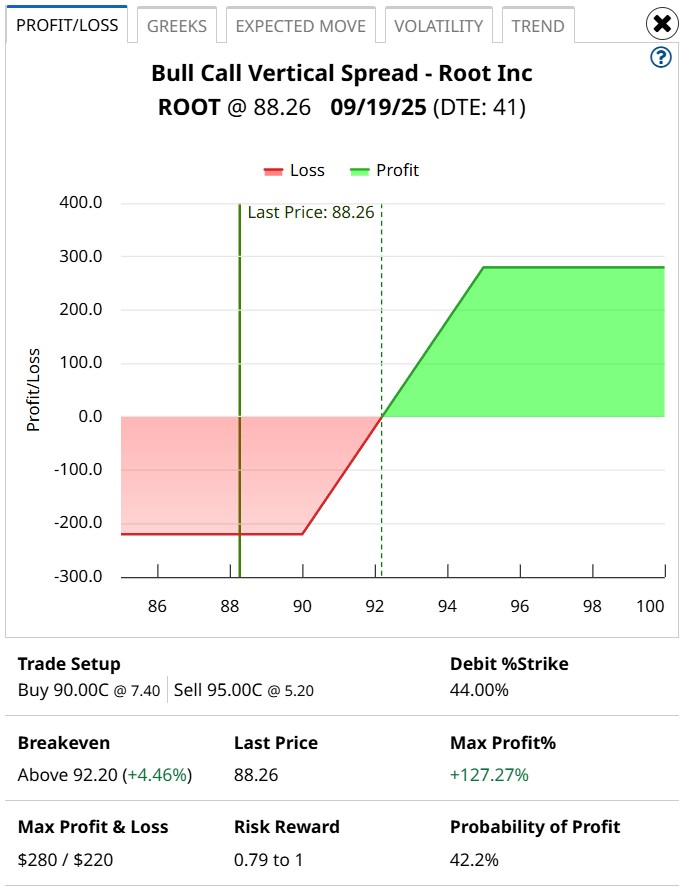Why Unusual Options Candidate Root (ROOT) Stock is Screaming for a Sentiment Reversal

Unusual options activity can be a hit-or-miss affair, particularly because the derivatives market is rather opaque. Given that puts and calls can be incorporated as debit or credit-based strategies, merely witnessing aberrant trades may not be enough to ascertain forward predictability. Further, because contracts can be incorporated into multi-leg strategies, the underlying implications are rarely intuitive.
Still, there are occasionally intriguing ideas that pop up. In my opinion, insurance specialist Root Inc (ROOT) is worth a closer look, especially if you’re a risk-tolerant speculator.
On Friday, ROOT stock represented one of the highlights of Barchart’s Unusual Stock Options Volume screener. Covering 500 of the most aberrant transactions relative to historical norms, this screener can potentially clue retail investors into big moves that could eventually occur in the open market. While correlation doesn’t always equal causation, it’s nevertheless a helpful place to jumpstart additional research.
Heading into the weekend, total options volume for ROOT stock hit 6,061 contracts. Though this figure doesn’t inherently sound particularly robust, it represented a 183.62% jump from the trailing one-month average. Further, call volume stood at 4,410 contracts while put volume was 1,651 contracts, yielding a ratio of 0.37.
On paper, this ratio signifies bullish intent. However, it’s better to spot-check options flow, which focuses exclusively on big block transactions likely placed by institutional investors. Here, we find that following Friday’s close, net trade sentiment landed at $31,100 above parity, thus slightly favoring the bulls. Importantly, the biggest transactions by dollar volume were for calls, strongly hinting that these are debit-based strategies.
Under such a framework, the trader pays a premium for the right to speculate on the underlying security. Therefore, a debit-based transaction must meet the minimum threshold of profitability to be considered successful. Because these were bought calls, the rational assumption is that the smart money believes ROOT stock will head higher.
Going Beyond the Narratives into the Statistical Case for ROOT Stock
While studying aberrations in the derivatives arena can be useful, one of the challenges is that there are plenty of informational gaps that you would have to fill with presumptions. Further, the relationship between unusual options and how the markets — both the open market and the derivatives sector — respond is not always clear or intuitive.
Therefore, rather than trying to understand how compelling ROOT stock options are relative to their informational profile — such as implied volatility — it’s arguably better to consider its statistical pathways and possibilities. This approach requires a new framework called discrete-event analysis.
Instead of analyzing price, it’s much more appropriate to consider behavioral states, which by nature are discrete events. The reason is that analysts often use discrete language to describe stocks, such as a “good price” to buy. However, there’s no objective standard for what a good price is because price is a continuous scalar signal.
In contrast, one of the few objective truths in the equities sector is as follows: at the end of the day, the market is either a net buyer or a net seller.
Here’s how we can apply this simple but profound concept to our research. In the last 10 weeks, the market voted to buy ROOT stock two times and sell eight times. During this period, the security incurred a negative trajectory. For brevity, we can label this sequence as 2-8-D.
Since its public market debut in October 2020, the 2-8-D sequence has materialized 12 times on a rolling basis. By classifying the price action of ROOT stock in this manner, we can better determine how the market responds to the sequence. In addition, we can stack the signal against other behavioral states to formulate a decision-tree logic:
L10 Category | Sample Size | Up Probability | Baseline Probability | Median Return if Up |
2-8-D | 12 | 91.67% | 42.57% | 7.19% |
3-7-D | 46 | 43.48% | 42.57% | 8.61% |
4-6-D | 43 | 46.51% | 42.57% | 6.85% |
4-6-U | 14 | 50.00% | 42.57% | 5.68% |
5-5-D | 28 | 25.00% | 42.57% | 19.18% |
5-5-U | 26 | 50.00% | 42.57% | 4.60% |
6-4-U | 26 | 46.15% | 42.57% | 14.21% |
7-3-U | 14 | 50.00% | 42.57% | 13.53% |
From the table above, we can see that the baseline probability or the chance that a long position in ROOT stock will rise on any given week is only 42.57%, a decidedly negative bias. This is effectively our null hypothesis, the probabilistic performance expectation assuming no mispricing. However, our alternative hypothesis is that, because of the 2-8-D sequence, the odds of upside success in the following week are 91.67%.
Further, under the positive pathway, the expected median performance is 7.19%. With ROOT stock closing at $88.26 on Friday, it’s possible that it could be on course to hit around $94.61, perhaps even a bit more if the market gods decide to be nice.
A Daring Proposition for the Aggressive Trader
Given the market intelligence above, the most aggressive (but still rational) bet would arguably be the 90/95 bull call spread expiring Aug. 15. While the payout is incredibly enticing at over 194% and though a pathway to the short strike price exists, it’s wildly risky — too many elements would have to fall in place perfectly.
A much more reasonable (but still risky) trade would be the 90/95 bull spread for next month’s expiration date of Sep. 19. This trade features a lower payout of 127%. However, the extra five weeks could be well worth it for those who want the relative peace of mind.

Of course, a lot rides on the viability of the 2-8-D sequence. Running a one-tailed binomial test reveals a p-value of 0.0006, which means that there’s a 0.06% chance that the implications of the signal could materialize randomly as opposed to intentionally. This figure more than meets the threshold of statistical significance, though the methodology is naturally optimistic due to the rolling 10-week intervals.
Still, in terms of intentionality versus randomness, ROOT stock represents the most empirically intriguing idea I’ve come across. To be clear, this doesn’t guarantee upside success. However, if you’re the speculative type, you’ll want to keep close tabs on this insurance specialist.
On the date of publication, Josh Enomoto did not have (either directly or indirectly) positions in any of the securities mentioned in this article. All information and data in this article is solely for informational purposes. For more information please view the Barchart Disclosure Policy here.